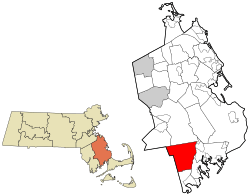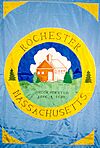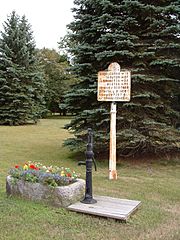Rochester, Massachusetts facts for kids
Quick facts for kids
Rochester, Massachusetts
|
|||
|---|---|---|---|

Rochester Town Hall
|
|||
|
|||

Location in Plymouth County in Massachusetts
|
|||
| Country | United States | ||
| State | Massachusetts | ||
| County | Plymouth | ||
| Settled | 1679 | ||
| Incorporated | 1686 | ||
| Government | |||
| • Type | Open town meeting | ||
| Area | |||
| • Total | 36.4 sq mi (94.2 km2) | ||
| • Land | 33.9 sq mi (87.9 km2) | ||
| • Water | 2.5 sq mi (6.4 km2) | ||
| Elevation | 29 ft (9 m) | ||
| Population
(2020)
|
|||
| • Total | 5,717 | ||
| • Density | 168.6/sq mi (65.0/km2) | ||
| Time zone | UTC−5 (Eastern) | ||
| • Summer (DST) | UTC−4 (Eastern) | ||
| ZIP Code |
02770
|
||
| Area code(s) | 508/774 | ||
| FIPS code | 25-57600 | ||
| GNIS feature ID | 0618350 | ||
| Website | www.townofrochestermass.com | ||
Rochester is a town in Plymouth County, Massachusetts, United States. In 2020, about 5,717 people lived here.
Rochester is part of the South Coast area of Massachusetts. This area includes towns and cities around Buzzards Bay, Mount Hope Bay, and the Sakonnet River.
Contents
History of Rochester
Rochester was first settled in 1679. The local Wampanoags people called these lands "Sippican." The name "Sippican" also referred to the local tribe.
The town officially became Rochester on June 4, 1686. It was named after Rochester, England. Many early settlers came from that English town.
Rochester originally included the areas of Mattapoisett, Marion, and parts of Wareham. The town grew because of shipbuilding and whaling in Mattapoisett Harbor.
Later, in 1852 and 1857, Marion and Mattapoisett became separate towns. This meant Rochester no longer had a coastline. Since then, Rochester has become a mostly rural town with many farms. It is known as a "Right to Farm" community.
Geography and Nature
Rochester covers about 36.4 square miles (94.2 km2). Most of this area is land, with some water. It is located on the western side of Plymouth County.
Neighboring towns include Lakeville and Middleborough to the north. To the east are Wareham and Marion. Mattapoisett is to the south. Acushnet and Freetown are to the west.
Rochester has several smaller areas like Bisbee Corner and North Rochester. The town is about 10 miles (16 km) northeast of New Bedford. It is also about 60 miles (97 km) south of Boston.
The Mattapoisett and Sippican rivers flow through Rochester. They both empty into Buzzards Bay. Many smaller brooks also flow into these rivers.
Important ponds in town include Snipatuit Pond and Long Pond. Great Quittacas Pond and Little Quittacas Pond are on the border with Lakeville. Rochester also has wildlife areas and a fish hatchery.
Getting Around Rochester
A small part of Interstate 495 goes through the northeast corner of Rochester. Route 58 and Route 105 also pass through the town center. You can also reach Rochester from Interstate 195.
For bus and air travel, the closest services are in New Bedford. Larger airports are T. F. Green Airport in Rhode Island and Logan International Airport in Boston.
A freight train line runs through the town. For passenger trains, the closest Amtrak station is in Providence. However, the MBTA commuter rail to Boston is also nearby in Middleborough-Lakeville.
People of Rochester
In 2020, the population of Rochester was 5,717 people. The town is made up of many families living together. Most households are married couples. About 39% of households have children under 18.
The average age in Rochester is about 38 years old. The town is a mix of people of all ages, from children to seniors.
Education in Rochester
Rochester is part of the Old Rochester Regional School District. This district serves about 2,700 students. It includes students from Rochester, Marion, and Mattapoisett.
Younger students in kindergarten through sixth grade attend Rochester Memorial School. Students in seventh and eighth grade go to Old Rochester Regional Junior High School. High school students attend Old Rochester Regional High School. Both regional schools are located in Mattapoisett.
The high school's sports teams are called the "Bulldogs." Their colors are red and white. They compete in the South Coast Conference. Their big football rival is Apponequet Regional High School.
Students can also choose to attend Old Colony Regional Vocational Technical High School. This school is in North Rochester. It offers many different hands-on programs like welding and auto repair. Their mascot is the Cougar.
For private school options, Tabor Academy in Marion is the closest.
Notable people from Rochester
- Joseph Bates (born in Rochester), who helped start the Seventh-Day Adventist Church.
- Tristam Burges (1770–1853) (born in Rochester), a U.S. Congressman and professor at Brown University.
- Selene Gifford (1901–1979), who was an Assistant Commissioner for the Bureau of Indian Affairs.
- David Wing Jr., who served as the Secretary of State of Vermont.
See also
 In Spanish: Rochester (Massachusetts) para niños
In Spanish: Rochester (Massachusetts) para niños





